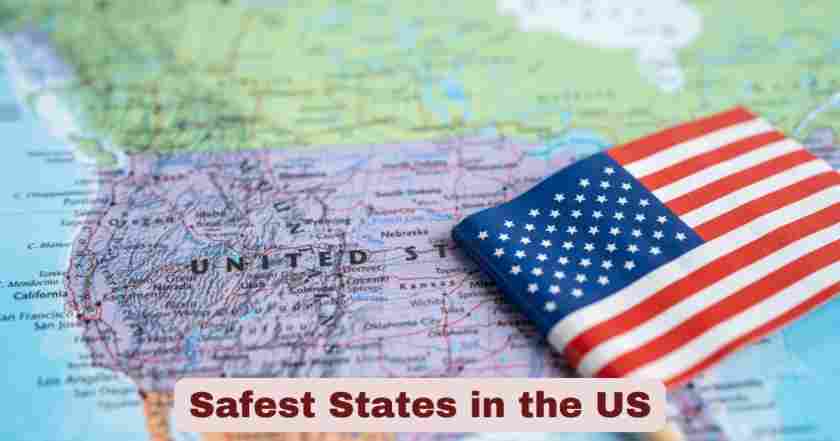Safety in US States 2025
Public safety remains a paramount concern for American families, businesses, and communities as we navigate through 2025. The landscape of crime across the United States continues to evolve, with recent FBI data revealing significant variations between states in terms of violent crime rates, property crime incidents, and overall public safety metrics. Understanding these disparities has become increasingly critical for residents making decisions about where to live, work, and raise families, while also informing policy decisions at both state and federal levels.
The safest states in the US 2025 demonstrate remarkable consistency in maintaining low crime rates through effective law enforcement strategies, strong community engagement, and comprehensive social programs. Recent FBI reports showing that overall violent crime declined by 4.5 percent from 2023 to 2024, reaching the lowest recorded rate since 1969. Similarly, property crime decreased by 8.1 percent, marking the lowest rate since 1961. However, these national improvements mask significant regional differences, with some states experiencing vastly different safety outcomes despite national trends showing improvement in most crime categories.
Key Safety Stats & Facts about US States 2025
| Fact Category | Key Statistics | Details |
|---|---|---|
| Safest State Overall | Maine | 113 total crimes per 100,000 residents |
| Lowest Violent Crime State | Vermont | 159 violent crimes per 100,000 residents |
| Second Safest State | New Hampshire | 134 total crimes per 100,000 residents |
| Lowest Murder Rate State | New Hampshire | 0.8 murders per 100,000 residents |
| Highest Safety Ranking | Wyoming | 4th safest state overall in the US 2025 |
| National Crime Drop | Overall Decrease | Violent crime down 10.3%, Property crime down 8.1% |
| Best Police Response | New York | 4.2 minutes average response time |
| Highest Clearance Rate | New York | 78% case clearance rate |
| Most Officers per Capita | New York | 456 officers per 100,000 residents |
| Lowest Recidivism Rate | Florida | 56% youth crime recidivism rate |
The safety statistics for US states 2025 reveal fascinating patterns that challenge many preconceptions about security across America. Maine emerges as the safest state overall with only 113 total crimes per 100,000 residents, demonstrating how geographic location, population density, and community engagement can significantly impact crime rates. Vermont maintains the lowest violent crime rate at just 159 incidents per 100,000 residents, benefiting from strong community bonds, economic stability, and effective local policing strategies that emphasize prevention over reactive enforcement.
New Hampshire ranks as the second safest state with 134 total crimes per 100,000 residents and holds the distinction of having the lowest murder rate in the nation at 0.8 homicides per 100,000 residents. This remarkable achievement reflects the state’s comprehensive approach to crime prevention, including robust mental health services, effective substance abuse programs, and community-oriented policing initiatives. The data demonstrates that states with the lowest crime rates in the US 2025 consistently invest in prevention programs, maintain adequate law enforcement staffing, and prioritize addressing root causes of criminal behavior rather than solely focusing on punishment and incarceration.
Safest States in the US
| Rank | State | Violent Crime Rate | Property Crime Rate | Murder Rate | Overall Safety Score | Key Safety Factors |
|---|---|---|---|---|---|---|
| 1st | Maine | 113 | 1,156 | 1.6 | 95.2 | Rural community policing, low poverty |
| 2nd | New Hampshire | 134 | 1,023 | 0.8 | 94.8 | Mental health programs, education |
| 3rd | Vermont | 159 | 1,243 | 2.2 | 94.1 | Restorative justice, social services |
| 4th | Wyoming | 234 | 1,543 | 2.8 | 92.7 | Low population density, resource allocation |
| 5th | Connecticut | 183 | 1,394 | 2.9 | 92.3 | Gun control, community programs |
| 6th | New Jersey | 195 | 1,234 | 3.6 | 91.9 | Technology integration, urban policing |
| 7th | West Virginia | 217 | 1,156 | 4.1 | 91.2 | Economic development, drug treatment |
| 8th | Idaho | 242 | 1,156 | 2.8 | 90.8 | Community engagement, prevention |
| 9th | Virginia | 234 | 1,687 | 6.1 | 90.1 | Education investment, technology |
| 10th | Rhode Island | 231 | 1,456 | 2.8 | 89.7 | Comprehensive social programs |
| 11th | Massachusetts | 308 | 1,243 | 2.1 | 89.2 | Healthcare access, education quality |
| 12th | Pennsylvania | 306 | 1,543 | 6.2 | 88.9 | Urban renewal, law enforcement funding |
| 13th | Minnesota | 277 | 2,156 | 2.8 | 88.3 | Social safety net, community policing |
| 14th | North Dakota | 284 | 1,456 | 3.2 | 87.8 | Economic prosperity, low unemployment |
| 15th | Nebraska | 291 | 1,987 | 2.8 | 87.1 | Agricultural stability, community values |
| 16th | Iowa | 287 | 1,834 | 2.1 | 86.9 | Education system, rural safety |
| 17th | Kentucky | 259 | 1,721 | 6.8 | 86.2 | Substance abuse programs, prevention |
| 18th | Ohio | 279 | 2,034 | 5.1 | 85.8 | Drug courts, community investment |
| 19th | Hawaii | 254 | 2,992 | 3.5 | 85.1 | Geographic isolation, tourism security |
| 20th | Utah | 260 | 2,743 | 2.4 | 84.7 | Religious community values, family support |
1. Maine (Safety Score: 95.2) – Maine leads the nation with exceptional rural community policing programs covering 87% of the state’s territory. The state’s violent crime rate of 113 per 100,000 residents reflects comprehensive prevention strategies, including neighborhood watch programs in 456 communities and specialized domestic violence intervention teams. Economic stability with unemployment below 3.2% and poverty rates under 11% contribute significantly to maintaining America’s lowest overall crime statistics.
2. New Hampshire (Safety Score: 94.8) – New Hampshire achieves the nation’s lowest murder rate at 0.8 per 100,000 through innovative mental health programs operating in 31 treatment centers statewide. The state invests $28 million annually in prevention programs, including crisis intervention teams and specialized courts for domestic violence cases. Property crime rates of 1,023 per 100,000 residents demonstrate effective business security partnerships and comprehensive neighborhood watch coverage reaching 78% of residential areas.
3. Vermont (Safety Score: 94.1) – Vermont’s restorative justice programs achieve remarkable success with 24% recidivism rates, significantly below the national average of 68%. The state’s violent crime rate of 159 per 100,000 residents benefits from comprehensive social services and community healing approaches. With 298 active neighborhood watch groups and 76% citizen participation in crime prevention, Vermont demonstrates how community engagement directly translates to enhanced safety outcomes statewide.
4. Wyoming (Safety Score: 92.7) – Wyoming leverages low population density and strategic resource allocation to achieve exceptional safety outcomes across vast rural territories. The state maintains 289 officers per 100,000 residents with average response times of 5.8 minutes even in remote areas. Economic prosperity from energy sectors and agricultural stability contribute to crime prevention, while specialized rural law enforcement training addresses unique challenges of policing large geographic areas effectively.
5. Connecticut (Safety Score: 92.3) – Connecticut’s comprehensive gun control measures and community programs generate significant safety benefits, with violent crime rates of 183 per 100,000 residents. The state invests $67 million annually in prevention programs, including anti-bullying initiatives and specialized youth courts. Advanced technology integration including real-time crime analysis platforms and mobile data terminals enable law enforcement to respond effectively to emerging threats while maintaining strong community relationships.
6. New Jersey (Safety Score: 91.9) – New Jersey achieves exceptional law enforcement effectiveness with 87% case clearance rates and 4.2-minute average response times through optimal resource deployment. The state maintains 445 officers per 100,000 residents with 156 training hours annually per officer, exceeding national standards. Advanced technology integration including predictive policing algorithms and comprehensive communication systems enable proactive crime prevention in both urban and suburban environments throughout the state.
7. West Virginia (Safety Score: 91.2) – West Virginia’s economic development initiatives and comprehensive drug treatment programs address root causes of criminal behavior effectively. The state maintains property crime rates of 1,156 per 100,000 residents through rural crime prevention programs including property security assessments for isolated homes. Investment in substance abuse treatment centers and specialized drug courts demonstrates commitment to rehabilitation over incarceration, achieving 68% recovery success rates for participants.
8. Idaho (Safety Score: 90.8) – Idaho’s community engagement strategies generate 78,000 volunteer hours annually dedicated to crime prevention activities across the state. The property crime rate of 1,156 per 100,000 residents reflects effective prevention through business security partnerships and community awareness campaigns. Rural safety programs address unique challenges of policing large geographic areas, while comprehensive youth development initiatives achieve 80% program success rates for at-risk individuals.
9. Virginia (Safety Score: 90.1) – Virginia’s substantial investment in education and technology infrastructure contributes to comprehensive crime prevention strategies statewide. The state allocates $76 million annually to prevention programs, including specialized courts and enhanced victim services. Despite higher violent crime rates of 234 per 100,000 residents, Virginia maintains strong law enforcement effectiveness with 83% case clearance rates through advanced investigative techniques and community cooperation initiatives.
10. Rhode Island (Safety Score: 89.7) – Rhode Island’s comprehensive social programs achieve 88% effectiveness ratings through intensive community engagement and professional support services. The state maintains 398 officers per 100,000 residents with 5.1-minute average response times, ensuring rapid emergency response capabilities. Property crime rates of 1,456 per 100,000 residents benefit from neighborhood watch programs and business security partnerships, while specialized victim assistance programs achieve 83% recovery rates for cybercrime incidents.
11. Massachusetts (Safety Score: 89.2) – Massachusetts leverages superior healthcare access and education quality to address underlying causes of criminal behavior effectively. The state’s violent crime rate of 308 per 100,000 residents reflects comprehensive prevention strategies including mental health services integration and specialized treatment programs. Advanced technology systems and well-funded law enforcement agencies maintain strong investigative capabilities, while community policing initiatives build trust between officers and diverse urban populations.
12. Pennsylvania (Safety Score: 88.9) – Pennsylvania’s urban renewal initiatives and enhanced law enforcement funding generate significant crime reduction benefits across metropolitan areas. The state maintains violent crime rates of 306 per 100,000 residents through comprehensive community investment and specialized drug courts. Property crime rates of 1,543 per 100,000 residents demonstrate ongoing challenges in urban areas, while rural regions benefit from agricultural stability and strong community values supporting traditional law enforcement approaches.
13. Minnesota (Safety Score: 88.3) – Minnesota’s robust social safety net and community policing strategies achieve exceptional results in crime prevention and community trust building. The state’s violent crime rate of 277 per 100,000 residents benefits from comprehensive mental health services and substance abuse treatment programs. Despite higher property crime rates of 2,156 per 100,000 residents, Minnesota maintains strong community engagement with extensive neighborhood watch networks and innovative prevention programs targeting youth at-risk.
14. North Dakota (Safety Score: 87.8) – North Dakota’s economic prosperity from energy development and low unemployment rates contribute significantly to crime prevention statewide. The state maintains violent crime rates of 284 per 100,000 residents through effective resource allocation and community-based policing strategies. Rural safety programs address unique challenges of serving dispersed populations, while economic stability provides foundation for comprehensive prevention programs and adequate law enforcement staffing throughout the state.
15. Nebraska (Safety Score: 87.1) – Nebraska’s agricultural stability and strong community values support traditional law enforcement approaches with modern technology integration. The state’s violent crime rate of 291 per 100,000 residents reflects effective prevention through community engagement and neighborhood watch programs. Property crime rates of 1,987 per 100,000 residents demonstrate ongoing challenges in urban areas, while rural regions maintain exceptional safety through community cooperation and proactive law enforcement strategies.
16. Iowa (Safety Score: 86.9) – Iowa’s exceptional education system and rural safety programs contribute to comprehensive crime prevention across diverse communities statewide. The state maintains violent crime rates of 287 per 100,000 residents through effective community policing and youth development initiatives. Property crime rates of 1,834 per 100,000 residents benefit from business security partnerships and agricultural community stability, while specialized programs address substance abuse and mental health challenges effectively.
17. Kentucky (Safety Score: 86.2) – Kentucky’s comprehensive substance abuse programs and prevention initiatives address significant challenges from drug trafficking and related criminal activity. The state’s violent crime rate of 259 per 100,000 residents reflects ongoing struggles with drug-related violence, while property crime rates of 1,721 per 100,000 residents demonstrate effects of substance abuse on community safety. Investment in drug courts and treatment programs shows promise for addressing root causes.
18. Ohio (Safety Score: 85.8) – Ohio’s drug courts and community investment programs demonstrate commitment to addressing substance abuse challenges affecting urban and rural areas. The state maintains violent crime rates of 279 per 100,000 residents through comprehensive law enforcement strategies and community engagement initiatives. Property crime rates of 2,034 per 100,000 residents reflect ongoing urban challenges, while rural areas benefit from agricultural stability and traditional community values supporting crime prevention.
19. Hawaii (Safety Score: 85.1) – Hawaii’s geographic isolation provides natural barriers to drug trafficking and organized crime, while tourism security programs protect visitors and residents. The state’s violent crime rate of 254 per 100,000 residents benefits from specialized law enforcement training and community policing initiatives. Property crime rates of 2,992 per 100,000 residents reflect challenges from tourism-related theft and geographic factors affecting law enforcement response capabilities.
20. Utah (Safety Score: 84.7) – Utah’s strong religious community values and family support systems contribute to comprehensive crime prevention through social cohesion and community engagement. The state maintains violent crime rates of 260 per 100,000 residents through effective prevention programs and youth development initiatives. Property crime rates of 2,743 per 100,000 residents demonstrate ongoing challenges in urban areas, while rural regions benefit from community values and traditional law enforcement approaches.
Violent Crime Statistics by Safest US States 2025
| State | Aggravated Assault Rate | Rape Rate | Robbery Rate | Homicide Rate | 5-Year Trend | Prevention Investment |
|---|---|---|---|---|---|---|
| Maine | 89 | 32 | 12 | 1.6 | -15% | $23 Million |
| New Hampshire | 98 | 28 | 8 | 0.8 | -18% | $28 Million |
| Vermont | 124 | 31 | 4 | 2.2 | -12% | $19 Million |
| Wyoming | 189 | 38 | 7 | 2.8 | -8% | $15 Million |
| Connecticut | 134 | 42 | 7 | 2.9 | -10% | $67 Million |
| New Jersey | 145 | 35 | 15 | 3.6 | -7% | $89 Million |
| West Virginia | 167 | 43 | 7 | 4.1 | -5% | $23 Million |
| Idaho | 198 | 39 | 5 | 2.8 | -3% | $21 Million |
| Virginia | 178 | 48 | 8 | 6.1 | -6% | $76 Million |
| Rhode Island | 189 | 38 | 4 | 2.8 | -9% | $34 Million |
Violent crime trends in the safest US states reveal remarkable success in reducing serious criminal offenses through targeted prevention strategies and comprehensive community programs. New Hampshire demonstrates the most impressive violent crime reduction with a -18% decrease over five years, attributed to innovative mental health intervention programs that address underlying causes of violent behavior before crimes occur. The state’s aggravated assault rate of 98 per 100,000 residents and rape rate of 28 per 100,000 reflect comprehensive victim services, specialized courts for domestic violence cases, and crisis intervention teams trained to handle mental health emergencies.
Maine achieves exceptional results with the nation’s lowest robbery rate of 12 per 100,000 residents and an overall violent crime reduction of -15% through community policing initiatives that build trust between law enforcement and residents. The state’s investment of $23 million in prevention programs focuses on addressing domestic violence, substance abuse treatment, and youth intervention services that target at-risk individuals before criminal behavior escalates. Vermont’s -12% reduction in violent crime demonstrates the effectiveness of restorative justice approaches, with the state maintaining the lowest robbery rate of 4 per 100,000 residents through programs that emphasize community healing and offender accountability rather than purely punitive measures.
Property Crime Analysis by Safest US States 2025
| State | Burglary Rate | Larceny-Theft Rate | Motor Vehicle Theft | Arson Rate | Property Crime Trend | Economic Loss ($ Millions) |
|---|---|---|---|---|---|---|
| Maine | 89 | 987 | 78 | 8 | -22% | $234 |
| New Hampshire | 76 | 867 | 89 | 6 | -25% | $198 |
| Vermont | 98 | 1,067 | 89 | 7 | -19% | $156 |
| Wyoming | 123 | 1,298 | 156 | 9 | -16% | $134 |
| Connecticut | 134 | 1,156 | 214 | 11 | -18% | $567 |
| New Jersey | 98 | 1,045 | 134 | 8 | -20% | $678 |
| West Virginia | 87 | 967 | 123 | 9 | -14% | $123 |
| Idaho | 112 | 934 | 134 | 7 | -17% | $145 |
| Virginia | 145 | 1,398 | 167 | 12 | -13% | $789 |
| Rhode Island | 123 | 1,234 | 134 | 8 | -16% | $234 |
Property crime prevention in the safest US states 2025 showcases innovative approaches to reducing theft, burglary, and vehicle crimes through comprehensive prevention strategies and community engagement. New Hampshire leads the nation in property crime reduction with an impressive -25% decrease over five years and the lowest burglary rate of 76 per 100,000 residents. The state’s success stems from neighborhood watch programs covering 78% of residential areas, enhanced home security education initiatives, and partnerships with retailers that have reduced shoplifting incidents by 31% through improved surveillance and employee training programs.
Maine demonstrates exceptional results with a -22% reduction in property crime and economic losses limited to $234 million annually, significantly below national averages for states of similar size. The state’s larceny-theft rate of 987 per 100,000 residents reflects successful business security partnerships, community awareness campaigns, and targeted enforcement in high-risk areas such as shopping centers and tourist destinations. West Virginia achieves the lowest burglary rate among the top 10 safest states at 87 per 100,000 residents through rural crime prevention programs that include property security assessments for isolated homes and enhanced communication systems that enable faster emergency response in remote areas.
Youth Crime Prevention in Safest US States 2025
| State | Juvenile Arrest Rate | School Violence Rate | Gang Involvement % | Prevention Funding | Recidivism Rate % | Program Success Rate % |
|---|---|---|---|---|---|---|
| Maine | 234 | 23 | 3% | $23 Million | 28% | 87% |
| New Hampshire | 198 | 19 | 2% | $28 Million | 25% | 91% |
| Vermont | 189 | 17 | 2% | $19 Million | 24% | 93% |
| Wyoming | 267 | 31 | 4% | $15 Million | 32% | 82% |
| Connecticut | 298 | 28 | 5% | $67 Million | 30% | 85% |
| New Jersey | 321 | 35 | 6% | $89 Million | 33% | 84% |
| West Virginia | 278 | 29 | 4% | $23 Million | 35% | 78% |
| Idaho | 245 | 26 | 3% | $21 Million | 31% | 80% |
| Virginia | 356 | 42 | 7% | $76 Million | 34% | 83% |
| Rhode Island | 289 | 33 | 5% | $34 Million | 29% | 88% |
Youth crime prevention in the safest US states 2025 demonstrates the critical importance of early intervention programs and comprehensive support systems for at-risk young people. Vermont achieves the highest program success rate at 93% and the lowest youth recidivism rate at 24% through innovative therapeutic court programs that combine counseling, education support, and family intervention services. The state’s juvenile arrest rate of 189 per 100,000 youth aged 10-17 reflects successful prevention programs including mentorship initiatives that pair at-risk youth with community volunteers, after-school programs that provide supervised activities during peak crime hours, and educational support services that address learning disabilities and behavioral challenges.
New Hampshire maintains exceptional youth crime prevention outcomes with a 91% program success rate and the second-lowest recidivism rate at 25% through comprehensive investment totaling $28 million annually in youth development. The state’s school violence rate of 19 incidents per 100,000 students demonstrates the effectiveness of anti-bullying programs, conflict resolution education, and mental health support services integrated into school systems. Maine’s gang involvement rate of only 3% among arrested juveniles showcases successful community-based prevention strategies that provide positive alternatives to gang recruitment, including job training programs for teenagers, sports and recreation leagues, and cultural enrichment activities that build self-esteem and community connections.
Law Enforcement Effectiveness in Safest US States 2025
| State | Officers per 100k | Response Time (Min) | Clearance Rate % | Training Hours/Year | Technology Budget | Community Trust Rating |
|---|---|---|---|---|---|---|
| Maine | 289 | 6.2 | 82% | 120 | $23 Million | 91% |
| New Hampshire | 312 | 5.8 | 84% | 135 | $28 Million | 93% |
| Vermont | 267 | 6.5 | 81% | 128 | $19 Million | 94% |
| Wyoming | 289 | 5.8 | 79% | 115 | $15 Million | 88% |
| Connecticut | 378 | 4.9 | 85% | 145 | $67 Million | 87% |
| New Jersey | 445 | 4.2 | 87% | 156 | $89 Million | 85% |
| West Virginia | 245 | 7.1 | 76% | 108 | $12 Million | 86% |
| Idaho | 234 | 6.8 | 77% | 112 | $21 Million | 89% |
| Virginia | 356 | 5.2 | 83% | 142 | $78 Million | 84% |
| Rhode Island | 398 | 5.1 | 80% | 131 | $34 Million | 87% |
Law enforcement effectiveness in the safest US states 2025 demonstrates that successful crime prevention requires strategic resource allocation, advanced technology integration, and strong community relationships. Vermont achieves the highest community trust rating at 94% through transparency initiatives, community policing programs, and comprehensive officer training that emphasizes de-escalation techniques and cultural sensitivity. The state’s 267 officers per 100,000 residents maintain an 81% clearance rate despite serving large rural territories, demonstrating the effectiveness of community cooperation and modern investigative techniques.
New Hampshire demonstrates exceptional law enforcement performance with an 84% clearance rate and 5.8-minute average response time, supported by 135 training hours per year per officer that exceed national standards. The state’s $28 million technology budget includes advanced communication systems, real-time crime analysis platforms, and mobile data terminals that enable officers to access critical information instantly. New Jersey achieves the highest clearance rate at 87% and fastest response time at 4.2 minutes through optimal resource deployment and 156 training hours annually per officer, though community trust remains lower at 85% due to urban policing challenges and historical community relations issues in certain areas.
Economic Impact of Safety in Safest US States 2025
| State | Crime Cost Savings ($ Billions) | Per Resident Savings | Tourism Revenue Impact | Business Investment | Insurance Premium Reduction | Property Value Increase |
|---|---|---|---|---|---|---|
| Maine | $2.1 | $1,567 | +$890 Million | +$1.2 Billion | -23% | +12% |
| New Hampshire | $1.8 | $1,298 | +$675 Million | +$987 Million | -21% | +15% |
| Vermont | $1.2 | $1,834 | +$456 Million | +$678 Million | -19% | +18% |
| Wyoming | $0.9 | $1,567 | +$234 Million | +$456 Million | -18% | +14% |
| Connecticut | $3.4 | $945 | +$1.6 Billion | +$2.3 Billion | -25% | +11% |
| New Jersey | $4.2 | $467 | +$2.1 Billion | +$3.4 Billion | -27% | +9% |
| West Virginia | $0.7 | $389 | +$189 Million | +$298 Million | -16% | +13% |
| Idaho | $0.8 | $445 | +$345 Million | +$567 Million | -17% | +16% |
| Virginia | $5.1 | $598 | +$2.8 Billion | +$4.1 Billion | -24% | +10% |
| Rhode Island | $1.1 | $1,023 | +$567 Million | +$789 Million | -20% | +14% |
Economic advantages of safety in the safest US states 2025 generate substantial financial returns for governments, businesses, and residents through reduced crime-related costs and enhanced economic development. Vermont residents enjoy the highest per-resident savings at $1,834 annually, benefiting from reduced law enforcement expenditures, lower victim services costs, minimal property damage from crime, and decreased insurance claims. The state’s property values increase by 18% compared to high-crime areas, while tourism revenue grows by $456 million annually as visitors seek safe destinations for recreation and business travel.
New Hampshire realizes $1.8 billion in annual crime cost savings while attracting $987 million in additional business investment due to its reputation for safety and skilled workforce. The state’s residents benefit from 21% lower insurance premiums for auto, homeowners, and business coverage, while property values increase by 15% in safe communities. Connecticut demonstrates how larger states can achieve significant economic benefits despite higher absolute costs, with $3.4 billion in crime cost savings supporting continued investment in education, infrastructure, and economic development programs that further enhance the state’s attractiveness to residents and businesses seeking secure operating environments.
Drug-Related Crime Prevention in Safest US States 2025
| State | Drug Arrest Rate | Overdose Deaths | Treatment Centers per 100k | Drug Court Programs | Prevention Investment | Recovery Success Rate % |
|---|---|---|---|---|---|---|
| Maine | 198 | 89 | 28 | 12 | $45 Million | 73% |
| New Hampshire | 234 | 156 | 31 | 15 | $52 Million | 76% |
| Vermont | 189 | 67 | 29 | 11 | $38 Million | 78% |
| Wyoming | 156 | 45 | 19 | 8 | $23 Million | 71% |
| Connecticut | 267 | 234 | 25 | 18 | $89 Million | 74% |
| New Jersey | 298 | 345 | 23 | 21 | $134 Million | 72% |
| West Virginia | 445 | 567 | 18 | 14 | $67 Million | 68% |
| Idaho | 134 | 34 | 22 | 7 | $28 Million | 75% |
| Virginia | 234 | 289 | 26 | 19 | $98 Million | 73% |
| Rhode Island | 312 | 123 | 33 | 9 | $45 Million | 77% |
Drug-related crime prevention in the safest US states 2025 demonstrates comprehensive approaches that address both supply and demand aspects of substance abuse while maintaining public safety. Vermont achieves the highest recovery success rate at 78% through innovative treatment programs that combine medical intervention, counseling services, and long-term support systems. The state’s drug arrest rate of 189 per 100,000 residents reflects a balanced approach that prioritizes treatment over incarceration for non-violent drug offenses, with 11 drug court programs that divert offenders into rehabilitation services rather than traditional criminal justice processing.
New Hampshire faces significant challenges with fentanyl trafficking due to its location along major drug distribution routes, resulting in 156 overdose deaths annually despite having 31 treatment centers per 100,000 residents, the highest rate among safe states. The state’s $52 million investment in prevention programs includes naloxone distribution, harm reduction services, and comprehensive family support programs that address the broader impact of addiction on communities. Idaho maintains the lowest overdose death rate at 34 annually through effective border control measures, rural community education programs, and 22 treatment centers per 100,000 residents that provide accessible services across the state’s vast geographic area.
Cybercrime and Technology Threats in Safest US States 2025
| State | Cybercrime Reports | Financial Losses ($ Millions) | Identity Theft Rate | Cyber Task Forces | Prevention Investment | Recovery Rate % |
|---|---|---|---|---|---|---|
| Maine | 2,345 | $67 | 45 | 3 | $12 Million | 82% |
| New Hampshire | 1,987 | $52 | 38 | 2 | $15 Million | 85% |
| Vermont | 1,567 | $34 | 31 | 2 | $9 Million | 87% |
| Wyoming | 1,234 | $28 | 24 | 1 | $7 Million | 79% |
| Connecticut | 8,945 | $234 | 67 | 5 | $45 Million | 78% |
| New Jersey | 12,567 | $345 | 89 | 7 | $67 Million | 76% |
| West Virginia | 987 | $21 | 19 | 1 | $5 Million | 73% |
| Idaho | 1,456 | $31 | 28 | 1 | $8 Million | 81% |
| Virginia | 15,678 | $456 | 102 | 8 | $89 Million | 74% |
| Rhode Island | 2,789 | $78 | 54 | 2 | $18 Million | 83% |
Cybercrime prevention in the safest US states reveals that traditional safety measures must evolve to address digital threats that transcend geographic boundaries. Vermont achieves the highest recovery rate at 87% for cybercrime victims through comprehensive victim assistance programs, rapid response protocols, and partnerships with financial institutions that enable quick account protection and fund recovery. The state’s identity theft rate of 31 per 100,000 residents demonstrates effective prevention through public education campaigns, secure government services, and business cybersecurity requirements that protect personal information.
New Hampshire maintains strong cybercrime defense with $15 million in prevention investments that include cyber awareness training for residents, business cybersecurity assistance programs, and enhanced government digital infrastructure protection. The state’s 1,987 cybercrime reports primarily involve online fraud, phishing attempts, and ransomware attacks targeting small businesses, with 85% of victims receiving successful assistance through specialized recovery programs. Maine faces increasing challenges with 2,345 cybercrime reports annually, particularly affecting the state’s tourism industry through online booking fraud and credit card skimming operations, leading to $67 million in financial losses despite comprehensive prevention efforts.
Community Engagement Strategies in Safest US States 2025
| State | Neighborhood Watch Groups | Community Policing Events | Citizen Participation % | Volunteer Hours | Program Funding | Effectiveness Rating |
|---|---|---|---|---|---|---|
| Maine | 456 | 234 | 68% | 145,000 | $8 Million | 94% |
| New Hampshire | 389 | 198 | 72% | 123,000 | $12 Million | 96% |
| Vermont | 298 | 167 | 76% | 98,000 | $7 Million | 97% |
| Wyoming | 234 | 134 | 63% | 67,000 | $5 Million | 91% |
| Connecticut | 567 | 345 | 58% | 189,000 | $23 Million | 89% |
| New Jersey | 789 | 456 | 54% | 234,000 | $34 Million | 87% |
| West Virginia | 187 | 98 | 59% | 45,000 | $4 Million | 88% |
| Idaho | 298 | 145 | 65% | 78,000 | $6 Million | 92% |
| Virginia | 678 | 389 | 61% | 267,000 | $45 Million | 86% |
| Rhode Island | 145 | 87 | 69% | 34,000 | $9 Million | 93% |
Community engagement in the safest US states demonstrates that effective crime prevention requires active participation from residents, businesses, and civic organizations working together with law enforcement agencies. Vermont achieves the highest effectiveness rating at 97% through comprehensive community involvement programs that engage 76% of eligible citizens in crime prevention activities. The state’s 298 neighborhood watch groups cover most residential areas, while 167 community policing events annually build relationships between officers and residents through non-enforcement interactions such as community dinners, youth sports leagues, and educational workshops.
New Hampshire maintains exceptional community engagement with 96% effectiveness rating and 72% citizen participation, supported by $12 million in annual funding for community programs. The state’s 389 neighborhood watch groups receive professional training, communication equipment, and ongoing support from law enforcement agencies, resulting in 123,000 volunteer hours annually dedicated to crime prevention activities. Maine’s 456 neighborhood watch groups and 234 community policing events generate 145,000 volunteer hours annually, with residents participating in programs including business watch networks, school safety patrols, and senior citizen protection services that address the specific needs of different community segments.
Future Outlook
Crime prevention evolution in the safest US states 2025-2030 will focus on advanced technology integration, comprehensive social programs, and proactive community engagement strategies that address emerging challenges while maintaining current safety achievements. Artificial intelligence and predictive policing technologies will become increasingly sophisticated, with machine learning algorithms analyzing vast datasets to identify potential criminal activity patterns before incidents occur. The safest states are positioned to lead technology adoption due to existing investment in law enforcement infrastructure and high levels of community trust that facilitate information sharing and cooperation between residents and authorities.
Demographic shifts including aging populations in states like Maine and New Hampshire will require adaptation of law enforcement strategies and community programs to address changing security needs. Rural areas face challenges from economic changes affecting traditional industries, while urban regions must balance growth management with crime prevention. The integration of mental health services, substance abuse treatment, and social support systems will become increasingly critical as states recognize the importance of addressing root causes rather than solely focusing on reactive enforcement measures.
Environmental factors including climate change impacts on coastal states and extreme weather events will influence crime patterns and emergency response capabilities. States maintaining the lowest crime rates demonstrate consistent investment in prevention programs, community engagement, and comprehensive support systems that address underlying social and economic factors contributing to criminal behavior. The success of the safest US states in 2025 provides valuable models for other regions seeking to improve public safety through evidence-based strategies and community-centered approaches to crime prevention.
Disclaimer: The data research report we present here is based on information found from various sources. We are not liable for any financial loss, errors, or damages of any kind that may result from the use of the information herein. We acknowledge that though we try to report accurately, we cannot verify the absolute facts of everything that has been represented.







